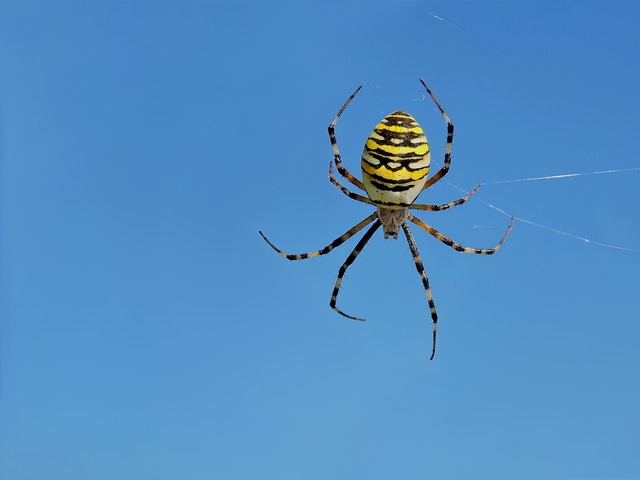Spider infestations are a common concern for property owners, but understanding spider behavior can prevent them. Professionals offer eco-friendly spider control through entry point sealing, inspections, and natural repellents. Common household spiders like the American House Spider and Black Widow require specific attention. Seasonal changes impact spider activity, with warmer months leading to increased mobility and infestations in basements and attics. Entry points such as cracks and unscreened vents make basements, attics, and crawl spaces prime locations for infestations. Implementing residential spider prevention tips and engaging commercial spider control services is crucial for creating safer environments.
In the realm of pest control, few insects inspire as much fear as spiders. From basements to attics and crawl spaces, these arachnids can establish thriving infestations, causing distress for both residential and commercial properties. Understanding spider behavior is the first step in effective prevention. This article explores specialized strategies to combat spider infestations, focusing on professional control, eco-friendly solutions, and long-term spider-proofing techniques. By delving into these methods, homeowners and business owners can reclaim their spaces and prevent unwanted eight-legged visitors.
Understanding Spider Infestations: Behavior and Entry Points
Spider infestations can be a significant concern for homeowners and commercial property managers alike. Understanding their behavior is the first step in effective spider infestation prevention. Spiders are arachnids that thrive in dark, secluded spaces, making basements, attics, and crawl spaces prime real estate for them. They spin intricate webs to trap prey and often use these as resting places. During the day, they tend to be less active and may retreat to their webs or hidden corners. However, at night, they become more active, venturing out to hunt or in search of new web-building locations.
Professional spider control services can employ various eco-friendly spider prevention solutions for both residential and commercial spaces. These strategies often involve identifying and sealing entry points, as spiders are known to find their way into buildings through cracks, gaps under doors, or around windows. Regular inspections and maintenance, including keeping areas clean and clutter-free, can deter spiders from making your space their home. Some professional services also utilize natural repellents and targeted treatments to disrupt spider populations without causing harm to humans or pets.
– Identifying common species of spiders in residential and commercial spaces
Spiders are a common sight in both residential and commercial spaces, with various species infiltrating homes and buildings. Identifying these spiders is an essential first step in effective spider infestation prevention. Common household spiders include the American House Spider, Black Widow, and the Brown Recluse, each requiring specific professional spider control methods. In commercial settings, the presence of spiders can be even more concerning, leading to increased demand for commercial spider control services.
Implementing spider prevention tips is crucial for both homeowners and business owners alike. Eco-friendly spider prevention solutions are gaining popularity as a preferred approach due to their minimal impact on the environment. These methods involve sealing entry points, maintaining proper ventilation, and utilizing natural repellents. For more severe cases or when professional expertise is needed, reliable pest control for spiders can offer tailored solutions. Effective spider-proofing your home involves regular inspections, prompt cleanup of clutter, and ensuring structures are well-maintained to deter these arachnids from setting up camp.
– Seasonal trends and weather influences on spider activity
Spider activity is closely tied to seasonal trends and weather patterns, which can significantly impact their presence in homes and commercial spaces. During the warmer months, spiders become more active as they seek food and suitable habitats. This increased mobility often leads to a surge in spider infestations, especially in basements, attics, and crawl spaces – areas that provide ideal conditions for them to thrive. Conversely, colder seasons may cause spiders to seek shelter indoors, making winter an opportune time for professional spider control services to implement targeted treatments.
Understanding these seasonal fluctuations is crucial for effective spider prevention strategies. Homeowners and commercial property managers can employ various eco-friendly spider prevention solutions to protect their spaces year-round. Regular inspections, sealing entry points, maintaining proper ventilation, and reducing clutter are essential spider prevention tips that can deter these arachnids from invading. For more severe or persistent infestations, engaging the services of a professional pest control team specializing in spider control is recommended for comprehensive and safe solutions, ensuring a spider-free environment in both residential and commercial settings.
– Typical entry points for spiders into basements, attics, and crawl spaces
Spiders often find their way into basements, attics, and crawl spaces through various entry points, making these areas prime real estate for spider infestations. Common routes include small cracks in foundations or walls, unscreened vents, gaps around pipes and cables, and openings in doors or windows. For residential and commercial properties alike, professional spider control services are invaluable when it comes to addressing these issues comprehensively.
Effective spider infestation prevention involves a combination of both short-term solutions and long-term strategies. Eco-friendly spider prevention solutions, for instance, focus on sealing entry points with materials like caulk or steel wool, eliminating potential hiding spots, and maintaining excellent hygiene in these areas. These measures significantly deter spiders from setting up shop, ensuring a safer and more comfortable living or working environment.
In light of understanding spider infestations and their entry points, implementing targeted prevention strategies is key to spider infestation prevention. For basements, attics, and crawl spaces, a multi-faceted approach combining professional spider control methods with eco-friendly spider prevention solutions is ideal. Regular inspections, sealing entry points, and maintaining proper ventilation are effective residential spider prevention tactics. Commercial spaces should rely on comprehensive commercial spider control services that address the unique challenges of larger structures. By adopting these spider prevention tips, you can effectively spider-proof your home or business, ensuring a safer and more comfortable environment.
